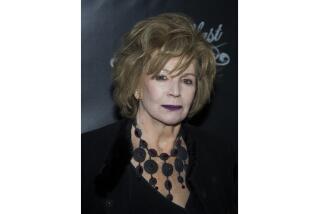Out of Atherton : THE DARK ROMANCE OF DIAN FOSSEY <i> by Harold T. P. Hayes (Simon & Shuster: $21.95; 384 pp.; 0-671-6339-2) </i>
- Share via
They put her in a cage with the other whites, and then one by one the men were taken out and slaughtered. She was raped repeatedly, but somehow through force of will survived, got out of the Congo and made it to Uganda, and finally Rwanda. She had been studying gorillas for six months in a freezing rain forest, living alone except for a few thieving African helpers. She buried this incident, only briefly alluding to it later under rare circumstances; buried it so that she would not be recalled by her sponsors, so that she could continue the study that became “Gorillas in the Mist,” the book and the movie. That is the Dian Fossey of story and legend.
Or, this never really happened, as some believe, including her then-fiance, Alexie Forrester, an old Africa hand and a man not likely to underestimate the continent’s capacity for barbarism or succumb easily to stories that do not quite add up. The late Harold T. Hayes in his biography, “The Dark Romance of Dian Fossey,” must grapple with a lot of stories that may or may not add up, but as he wends his way through the various accounts (the book is based on more than 200 interviews) including Fossey’s own talent for fabrication, he keeps his eye on one thing: Dian Fossey, the extraordinary woman who more than any other single person brought mountain gorillas into the conciousness of the world.
Those who have read Farley Mowat’s uncritical biography, “Woman of the Mists,” are in for a kind of jolt--the same characters and incidents occur but with a completely different interpretation. Also, the warm Dian Fossey of her journals and letters is largely absent here--whether for legal reasons that limit use of such material, or for other reasons, it is hard to say.
What stands out in both books is a very powerful human being. She was a person who could nurse and sleep with orphaned infant gorillas, the diarrhea from the sick youngsters gushing across her, ignore her rotting teeth and swollen jaw, fight off African poachers as a witch, start letter wars with European zoos, work without salary while living on potatoes, chain-smoke as she struggled up 10,000-foot peaks, and in one year make 485 hours of observations of mountain gorillas (versus renowned scholar George Schaller’s 466 in 18 months). All this accomplished in an environment where a strapping American male assistant went from 195 to 145 pounds in about three months, and then left the region entirely. She was a piece of work, and this book tells us as much as we are likely to learn about how she got the way she was. It is compelling, disturbing, and for those who dream of renown and rewards without the pain of earning them a useful corrective.
She was born in California to a fashion model mother and a father, who after a divorce had no contact with her until she was an adult. Her stepfather was rich, and she was reared comfortably in Atherton. Over six feet tall, she had little sense of selfesteem, became a therapist and fled her family for a position working with handicapped children in Louisville, Ky., a deadend job where she stayed 10 years. She lived alone in the woods, took in stray dogs and seemed to never have a man in her life. By her mid-30s, she sensed some kind of emptiness, and though engaged to Rhodesian Alexie Forrester, pitched herself to Louis Leakey as another Jane Goodall, and by Jan. 1, 1967, was high on the mountain studying gorillas. She had no background in the sciences, was not a naturalist, knew little of Africa, was physically unfit, and lacked any talent whatsoever for dealing with people of other cultures. And of course, in the end she succeeded.
In this age of bloated biographies of virtual nonentities, Hayes has produced a bare-bones text crammed with significant incidents and one that refrains from psychobabble as a form of explanation. And Fossey is the kind of person who would tempt any one to produce some kind of explanation for her behavior. Although there are clues from her childhood (abandoned by her natural father, hostile to her stepfather, convinced of her unattractiveness) her coldness and fear of getting close to people, the physical facts of her life in Africa would produce either an iron will or total breakdown in many people. The national park she lived in was 25 miles by four miles, and set in Rwanda, which is one of the most overpopulated nations in the world with 600 people per square mile. When she arrived, the 400 mountain gorillas were tottering on the lip of extinction, and when she died in 1985, a little more than 200 remained and the park had shrunk. Choosing intimate contact with the gorillas over the calm, objective viewing of them (to the continuing consternation of many scientists), she gradually became accepted by the various groups, formed what looks like friendships with individuals such as the famous Digit, and finally was able to sit inside the groups and move with them, be touched by them, seemingly to be accepted by them--much of this captured on film by the great love of her life, Bob Campbell. And while her research continued, the gorillas were slaughtered by poachers stealing infants for European zoos (in one period in 1948, 60 gorillas died protecting 11 infants seized for zoos), by natives seeking skulls for collectors, and by her neighbors apparently outraged by her brutal behavior toward them. She threatened them with black magic, had their genitals flogged with stinging nettles, shot their cattle, kidnaped their children, and sought to have poachers killed on sight. By 1979, she was writing letters such as this one to the American ambassador in Rwanda: “It is only a matter for the President to give the order--KILL--(because) the prisons are already overcrowded and this is the only way we are going to be able to protect the remaining gorillas.” Nor was she much kinder to the various researchers and helpers that flocked from around the world to join her in her work. The book is littered with former friends now enemies.
And of course, in late December, 1985, she was slaughtered in her cabin on the mountain by a person or persons unknown. They made her grave in her gorilla cemetary where she had buried her friends like Digit. Hayes doesn’t solve her murder, but he does leave one with the feeling that it hardly matters--a lot of people had reason to hate Fossey, and by the time of her death, drinking heavily, her lungs shot from smoking, she didn’t seem to like herself much either.
This is hardly a debunking biography or an expose but it does make us face the fact that people we admire may not be people we would like had we met them. I doubt that it will be the last word on this remarkable person, but it certainly is the most searing. She has been a legend, a movie, books and a cause. Now she is made flesh. Fossey did a great thing and paid a great price--her loneliness at times is almost unbearable. She drew our attention not just to gorillas but to possibilities of other forms of life. No one who reads this book will likely forget her sitting in the forest with two blond-haired little girls while a gorilla strokes their locks with amazement. I certainly won’t.
More to Read
Sign up for our Book Club newsletter
Get the latest news, events and more from the Los Angeles Times Book Club, and help us get L.A. reading and talking.
You may occasionally receive promotional content from the Los Angeles Times.







